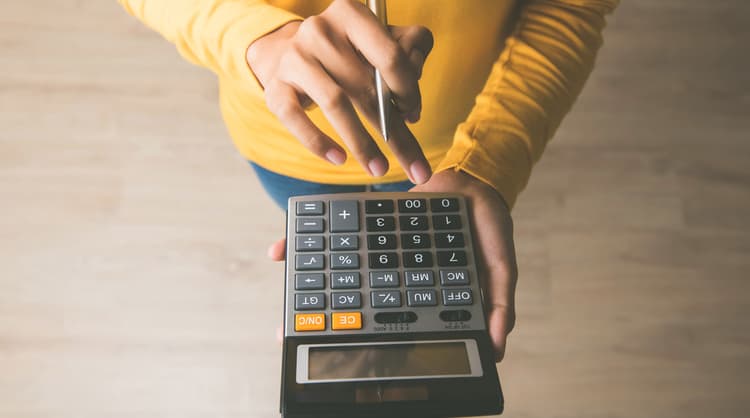Working from home during the coronavirus? Here's what you can claim back on tax

The COVID-19 pandemic has pressed much of Australia's workforce to adopt work-from-home arrangements, with many experiencing the lifestyle for the first time.
On top of the many benefits teleworking has offered thus far – including up to a 13% increase in employee performance, a stronger focus on tasks and greater autonomy over their workload – remote workers now have new tax benefits to consider.
Early April saw the introduction of the ATO’s “80-cents-an-hour” method for deducting work-from-home expenses; an arrangement SkillsTalk explore further below, along with what you can claim as a teleworker.
The new ATO rules - how to calculate home office expenses for tax

The method also applies to each individual member of the household. A couple living together, for example, can individually make their claim on the 80-cents-an-hour rate.
This isn’t to say that individuals are restricted from making their claims under existing methods or arrangements – such as the old, “52-cents-per-work-hour” method; though any claims under the new “shortcut” cannot be used for calculated expenses prior to March 1, 2020. Such expenses must be calculated from pre-existing work-from-home tax arrangements.
The ATO claims this new method can make tax time easier for those working from home for the first time. Due to its simple rules and requirements, the arrangement may reduce the need for reviews and audits, as people are likely to make less mistakes in their calculations.
Though providing an easier approach to their tax claims, a stark downside to the method is the potential to “underclaim” expenses; leaving some stuck in choosing between this new “shortcut” or opting for previous tax return arrangements.
The “simple”, new method vs. the old method
The new method may simplify your tax return process, though experts warn the possibility of lower returns.
In an ABC News article, 5ways Group director and accountant Paul Meissner stated that those paying between $80 to $100 per month for multiple work expenses such as home internet, phone use, and peripheral devices such as printers and scanners – using the old, 52-cents method can allow them to claim greater deductions.
He emphasises that, “if you are now doing 40 hours per week work from home, the extra shortcut claim is only $40 per month.”
Since the 80-cents shortcut encompasses a broad range of items, individuals may reap a greater tax return by claiming each of these expenses separately. In fact, Mark Chapman from H&R Block explains that taxpayers are generally better off claiming individual costs rather than relying on “flat rate” arrangements – this including the new shortcut method.
However, experts also predict the likelihood of Australians to choose simplicity over larger deductions. While it may seem like a large trade-off on the outset, the shortcut method eliminates the tedious, extensive work required to track and document all your work-related expenses. Individuals are simply required to keep a log of their work hours, multiply these by 80 cents – and they’re good to go.
Those opting for the older method require meticulous record-keeping to calculate the necessary expenditure come tax time. Fortunately, there are a wide range of online tools and apps now available to help track one’s expenses, including the free ATO tool, myDeductions.
What you’ll need to make your claim

For those who decide to go with the 52 cents method, taxpayers must carefully apportion their use of work-related items between personal and business-related needs. Workers must also provide the total number of hours spent working from home, along with a log or diary representing a four-week period of their usual pattern of working at home. The diary must also include any small expenses ($10 or less) totalling no more than $200, your work-related internet use, and the percentage of the year you used depreciating work-exclusive assets.
Additionally, proof of expenses, such as receipts or utility bills, must be included.
The detailed nature of this method is exactly what makes it a trickier process, which may prove even more challenging among those living with family or in a multi-person household. Calculating your use of internet data - while having other family members or roommates on the same network - can make the apportioning process a challenge. This is where the shortcut, 80-cents method comes in handy.
Still, experts recommend the older method among those who are “heavy users” of phone and internet, as such hefty investments can lead to greater reductions under the old arrangement.
Restrictions to keep in mind
The ATO’s new shortcut method covers all the following expenses:
- the decline in value (and repair) of capital items, such as furniture and furnishings
- electricity for lighting, cooling/heating, and for running work-related electronic items (i.e. your computer); and gas heating expenses
- cleaning expenses
- phone costs (along with your device’s decline in value)
- internet costs
- computer-related consumables (i.e. printer ink)
- stationery
- the decline in value of your computer, laptop, or similar device
The ATO also states that one doesn’t have to incur all of the aforementioned expenses, though they must have incurred additional expenses in some of the above categories as a result of new work-from-home arrangements.
Those opting for this shortcut method are also prohibited from claiming a further deduction on any of the listed expenses. Additionally, you can’t claim any occupancy-related expenses (i.e. mortgage interest, rent) or general household items that your employer may have otherwise provided you in the workplace (i.e. coffee, tea, toilet paper).
The 52-cent, fixed rate method covers all expenses for the following:
- electricity and gas for heating, cooling, and lighting
- cost of repairs to your home office equipment, furniture, and furnishings
- the decline in value of your home office furniture (i.e. your office desk)
This method does not include work-related use for phone and internet expenses; computer-related consumables and stationery and the decline in value of your electronic equipment – thus, calculations for these must be done separately.
As with the 80-cent method, taxpayers are also restricted from including any general household items on their claim; along with costs related to children and their education, and any expenses you were reimbursed for by your employer.
Individuals can find more detailed information on both the 80-cent method and 52-cent method on the ATO’s website.
Play it smart with your tax return
The method you ultimately choose for your tax return will depend on your working habits, lifestyle, and financial needs. Taxpayers are encouraged to weigh out their claim options to avoid paying more tax than required or making unnecessarily extensive calculations on all work-from-home-related expenses.
Whatever you opt for, be sure to have all the documents and evidence necessary to make this year’s tax return as smooth and efficient a process as possible.
This article should not be taken as expert financial advice. Please consult a financial specialist for further advice on your circumstances.


)
)

